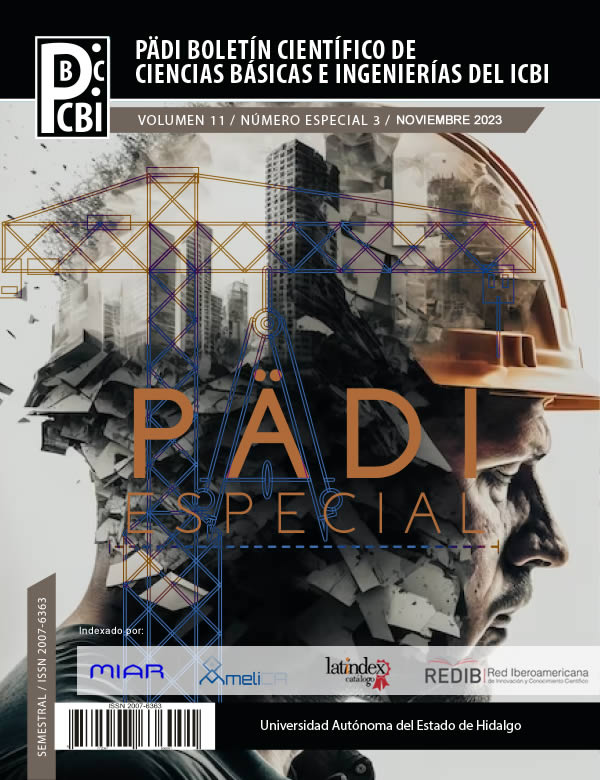Gray water treatment for popular social interest housing
Abstract
Water stress continues to increase around the world, as the volume of quality water for human consumption reduces. In central Mexico, where the State of Hidalgo is located, the availability of water per capita is less than 2000 m3/inhabitant/year. In this exploratory study, a grey waters filtration system is proposed for its reuse in domestic activities with the purpose of mitigating the water shortage in the municipality of Mineral de la Reforma, Hidalgo. The system is intended for a one-level social housing, with a maximum capacity of 4 people. The system was integrated with filters in series, obtained from natural sources and ornamental plants. The affluent and effluent were analyzed obtaining favorable results, reducing chemical oxygen demand in 77.6%, enabling the treated water for watering and cleaning, becoming a continuous way of saving drinking water.
Downloads
References
Arce, A.L., Calderón, C.G., Tomasini, A.C. (s.f.). Fundamentos técnicos para el muestreo y análisis de aguas residuales. Serie autodidáctica de medición de la calidad del agua. Comisión Nacional del Agua, Instituto Mexicano de Tecnología del Agua, México
Alcudia, D., García, A. P., & López, A. (2022). Estrés hídrico: problemáticas y soluciones. Un análisis con enfoque jurídico [Proyecto jurídico de titulación, Universidad Iberoamericana, Puebla]. https://repositorio.iberopuebla.mx/bitstream/handle/20.500.11777/5598/Proyecto%20juridico%20final%20ASE%20III%20Daniel%20Alcudia%20y%20equipo.pdf?sequence=1&isAllowed=y
APHA (2012) Standard Methods for the Examination of Water and Waste Water. 22ª ed. American Public Health Association, American Water Works Association, Water Environment Federation, Estados Unidos de America
Boege, E. &. Kral, R. (2011). Sistema de tratamiento para aguas jabonosas. http://www.paginasverdesxalapa.com/pdf/sistemacaserotratamientoaguas_eckartboege_rolfkral.pdf.)
Bigurra, C. A.., Rodríguez, G. A. V., & Lizárraga-Mendiola, L. (2021). Reducción de la huella de escasez hídrica y medidas de conservación del agua en la vivienda. Vivienda y Comunidades Sustentables, (9), 61-75.
Comisión de Agua y Alcantarillado de Sistemas Intermunicipales, CAASIM. (2019, 23 de septiembre). “Tarifas mensuales de agua potable aplicadas para servicio doméstico en la ciudad de Pachuca de Soto”. http://caasim.hidalgo.gob.mx/pag/tarifas.html. Consultado: 23 de septiembre de 2019.).
Díaz-Padilla, G., Sánchez-Cohen, I., Quiroz, R., Garatuza-Payán, J., Watts-Thorp, C., Cruz-Medina, I. R., & Guajardo-Panes, R. A. (2011). Variación espacio-temporal de la precipitación pluvial en México: una aproximación a la evaluación de impactos. Tecnología y ciencias del agua, 2(4), 51-64.
Fane S., Reardon, C., Milne, G. (2013). “Wastewater Reuse. Australia´s Guide to Environmentally Sustainable Homes”. https://www.yourhome.gov.au/water/wastewater-reuse
Instituto Nacional de Estadística, Geografía e Informática, INEGI (2015). Datos del censo de población y vivienda. Información sobre agua potable y alcantarillado. Disponible en: http://cuentame.inegi.org.mx/territorio/agua/dispon.aspx?tema=T. Consultado: 9 de septiembre de2019.).
Maita-Arias, J. (2019). Implementación de filtros verdes para mejorar el efluente en el sistema de alcantarillado del distrito de Matahuasi. [Tesis de licenciatura, Universidad Peruana de los Andes]. https://repositorio.upla.edu.pe/handle/20.500.12848/937
Organización de las Naciones Unidas, Consejo Económico y Social. Comisión de Estadística. (29 de febrero de 2016) Informe del Grupo Interinstitucional y de Expertos sobre los Indicadores de los Objetivos de Desarrollo Sostenible, E/CN.3/2016/2/Rev. 1. https://unstats.un.org/unsd/statcom/47th-session/documents/2016-2-IAEG-SDGs-S.pdf
UN-Water. Summary Progress Update 2021: SDG 6 - water and sanitation for all. UN-Water Publications. 2021
Meléndez-Pérez, J. A., Lemos-Lima, M. M. C., Dominguez, I., & Oviedo-Ocaña, E. R. (2019). Reutilización de aguas grises domésticas para el uso eficiente del recurso hídrico: aceptación social y análisis financiero. Un caso en Portugal. Revista UIS Ingenierías, 18(1), 223–236. https://doi.org/10.18273/revuin.v18n1-2019020
Robles-Ortega, M. A. (2019). Evaluación de la operación de la planta de tratamiento de aguas servidas pantanos secos artificiales de Puerto Azul. Guayaquil. ULVR. Facultad de Ingeniería, Industria y Construcción Carrera de Ingeniería Civil. 125 p. http://creativecommons.org/licenses/by-nc-sa/3.0/ec/
Zerega, G. (2022, 17 de agosto). Ciudad de México (también) enfrenta los recortes de agua: “Si de por sí ya no tenemos, ahora menos”. El País. https://elpais.com/mexico/2022-08-17/ciudad-de-mexico-tambien-enfrenta-los-recortes-de-agua-si-de-por-si-ya-no-tenemos-ahora-menos.html
Copyright (c) 2023 Marcos Irán Bautista-Gómez, Diego Alberto Rodríguez-Reyes, Iván Erick Castañeda-Robles, María del Refugio González-Sandoval, Jonathan Enrique Escalante-Lozano

This work is licensed under a Creative Commons Attribution-NonCommercial-NoDerivatives 4.0 International License.













